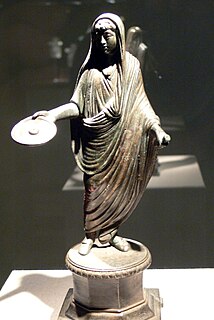
Cappadocia is a historical region in Central Anatolia, largely in the Nevşehir, Kayseri, Kırşehir, Aksaray, and Niğde Provinces in Turkey.
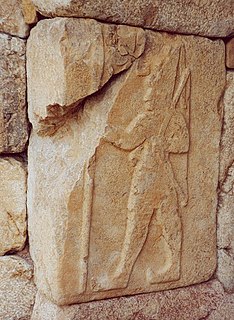
Suppiluliuma II, the son of Tudhaliya IV, was the last known king of the New Kingdom of the Hittite Empire, ruling c. 1207–1178 BC, contemporary with Tukulti-Ninurta I of the Middle Assyrian Empire.
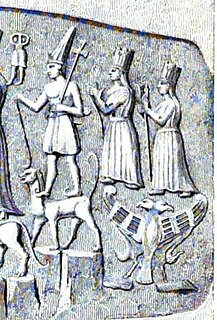
Šarruma or Sharruma was a Hurrian mountain god, who was also worshipped by the Hittites and Luwians.

The states that are called Neo-Hittite or, more recently, Syro-Hittite were Luwian-, Aramaic- and Phoenician-speaking political entities of the Iron Age in northern Syria and southern Anatolia that arose following the collapse of the Hittite Empire in around 1180 BC and lasted until roughly 700 BC. The term "Neo-Hittite" is sometimes reserved specifically for the Luwian-speaking principalities, like Milid and Carchemish. However, in a wider sense the broader cultural term "Syro-Hittite" is now applied to all the entities that arose in south-central Anatolia following the Hittite collapse, such as Tabal and Quwê, as well as those of northern and coastal Syria.

The İvriz relief is a Hittite rock relief in south-central Anatolia, located in the town of Aydınkent, formerly called İvriz. The rock relief is on a rock face near the source of the İvriz Suyu, whose water has damaged the relief in modern times. It depicts the late 8th-century BC king Warpalawas and the storm-god Tarhunzas and is accompanied by a hieroglyphic Luwian inscription. Rock reliefs are a prominent aspect of Hittite art.

Šauška or Shaushka was a Hurrian goddess who was also adopted into the Hittite pantheon. She is known in detail because she became the patron goddess of the Hittite king Hattusili III following his marriage to Puduhepa, the daughter of the goddess' high priest. Her cultic center was Lawazantiya in Kizzuwatna.

Not to be confused with Karatepe, Termez, Uzbekistan, where a Buddhist mural from 3rd century was found, nor Kara Tepe Refugee Camp in Greece.

The Stela of Akhenaten and his family is the name for an altar image in the Egyptian Museum in Cairo which depicts the Pharaoh Akhenaten, his queen Nefertiti, and their three children. The limestone stela with the inventory number JE 44865 is 43.5 × 39 cm in size and was discovered by Ludwig Borchardt in Haoue Q 47 at Tell-el Amarna in 1912. When the archaeological finds from Tell-el Amarna were divided on 20 January 1913, Gustave Lefebvre chose this object on behalf of the Egyptian Superintendency for Antiquities instead of the Bust of Nefertiti.

The Hanyeri relief is a Hittite rock relief near Hanyeri on the road from Tufanbeyli to Develi in Tufanbeyli district in Adana Province, about 80 km southeast of Kayseri, in Turkey. In Hittite times, the route over the 1960 m high Gezbeli Pass through the Taurus Mountains, which connected the Hittite heartland on the Kızılırmak River with Cilicia, passed by here. At the other end of the pass, to the northwest, is the İmamkullu relief. Rock reliefs are a prominent aspect of Hittite art.
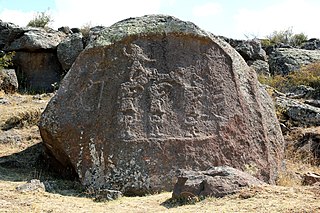
The Hittite İmamkullu relief is a rock relief near the town of İmamkullu in Tomarza district in Kayseri Province, Turkey. In Turkish it is known as Yazılı Kaya and Şimşekkaya. Rock reliefs are a prominent aspect of Hittite art.
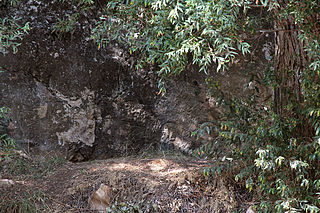
The two Taşçı reliefs are rock reliefs from the time of the Hittite empire. They are two kilometres south of Taşçı in Develi district, Kayseri Province, Turkey. They are known in Turkish as Yazılı Kaya. Rock reliefs are a prominent aspect of Hittite art.
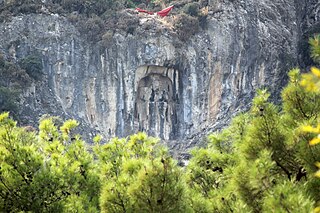
The Manisa relief, also known as the Akpınar relief and the Cybele relief, is a Hittite rock relief at Akpınar, about 5 km east of the Turkish provincial capital of Manisa above an amusement park on the road to Salihli. It depicts a Hittite divinity. Rock reliefs are a prominent aspect of Hittite art.

The Hemite relief is a Hittite rock relief at Gökçedam in the central district of Osmaniye Province in Turkey, about 20 km northwest of the provincial capital of Osmaniye. Rock reliefs are a prominent aspect of Hittite art.
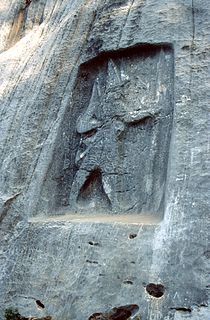
The Hittite / Luwian Karabel relief is a rock relief in the pass of the same name, between Torbalı und Kemalpaşa, about 20 km from Izmir in Turkey. Rock reliefs are a prominent aspect of Hittite art.

The Karasu relief, also known as the Süpürgüç relief after the earlier name of the nearby town of Akbudak, is a rock relief located on a tributary of the Euphrates and derives from the Neo-Hittite period. It depicts a protective god standing on a deer. Rock reliefs are a prominent aspect of Hittite art.
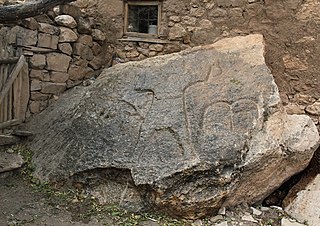
The Hittite Gökbez relief is a rock relief at Gökbez and dates from the time of the Neo-Hittite states. Rock reliefs are a prominent aspect of Hittite art.

Karatepe-Aslantaş Open-Air Museum is an open-air museum in Osmaniye Province, Turkey. Karatepe is the location while Aslantaş refers to the lion figure on stone sculptures. The site is situated inside a nationalpark with the same name.
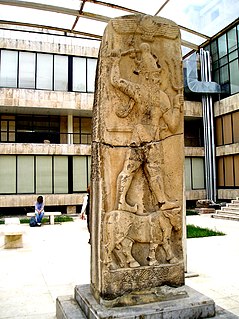
Tarḫunz was the weather god and chief god of the Luwians, a people of Bronze Age and early Iron Age Anatolia. He is closely associated with the Hittite god Tarḫunna and the Hurrian god Teshub.
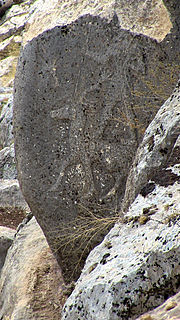
Runtiya was the Luwian god of the hunt, who had a close connection with deer. He was among the most important gods of the Luwians.

Tiwaz was the Luwian Sun-god. He was among the most important gods of the Luwians.









